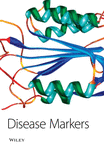Patterns of Global DNA and Histone Methylation Appear to be Similar in Normal, Dysplastic and Neoplastic Oral Epithelium of Humans
Abstract
Although there is growing interest in the possibility that alterations in histone methylation may play a role in carcinogenesis, it has not been explored adequately in humans. Similarly, there are no reports of associations between this and a similar epigenetic event, DNA methylation. Using immunohistochemical staining, we compared the methylation of DNA and histones in histopathologically normal oral epithelium, dysplastic oral lesions, and squamous cell cancers (SCCs) from subjects with squamous cell cancer (n = 48) with those of normal oral epithelium from subjects without oral cancer (n = 93) who were matched on age and race. Monoclonal antibodies specific for 5 methyl cytosine (5-mc), lysine 4 of histone H3 (H3-Lys4), and lysine 9 of histone H3 (H3-Lys9) were used in this study. The percentages of cells positive and a weighted average of the immunostaining intensity scores were calculated for each of these tissues, and Spearman correlation analyses were employed to study associations between DNA and histone methylation. Correlations between DNA and histone methylation, H3-Lys4 and H3-Lys9 were positive and statistically significant in all tissue types; they were strongest in normal oral epithelium from non-cancer subjects (n = 0.63, p < 0.001 and r = 0.62, p < 0.001 respectively). Similarly, the positive correlations between H3-Lys4 and H3-Lys9 were statistically significant in all tissue types and strongest in normal oral epithelium from non-cancer subjects (r = 0.77, p < 0.001). Patterns of DNA and histone methylation are similar in tissues across the spectrum of oral carcinogenesis, and there is a significant positive association between these two epigenetic mechanisms.




